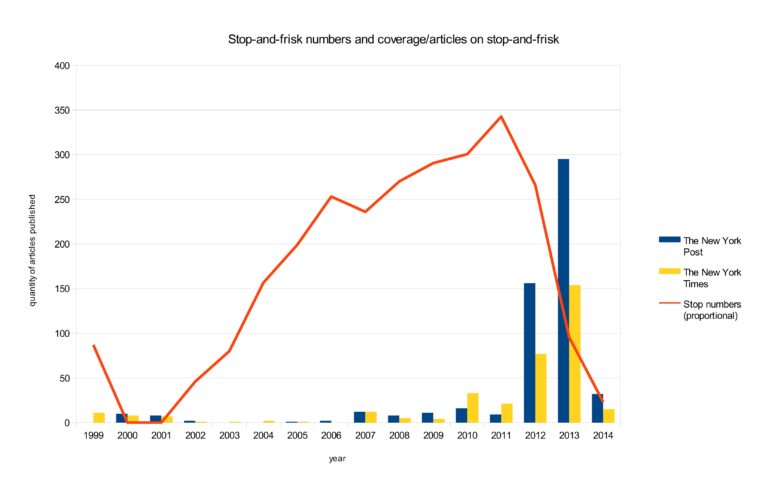
Moritz Wichmann
The New York Times and the New York Post are among the handful of media outlets that truly express and shape the city’s agenda. Together the papers published 935 articles that dealt with stop-and-frisk between 1999 and 2014. Over those 15 years, stop-and-frisk was covered in different ways by the different papers, and at different times.
From 2001 to 2011 stops rose 600 percent, from about 100,000 to almost 700,000 a year, then fell sharply to 46.000 in 2014. However, the coverage lagged those numbers—resulting in a huge surge of coverage even as the policing tactic itself was fading—for various reasons.
The first is the political context. At the end of the 90s, stop-and-frisk came up as a topic in the wake of the death of Amadou Diallo. But in post-September 11 New York, there was an almost complete silence on the issue, with the few articles mentioning it in the New York Times putting a positive light on the NYPD as “fighting crime and gaining favor.” Criticism of stop-and-frisk barely registered. That changed as crime continued to decrease, the threat of terrorist attack seemed to wane and a more accurate picture of policing in New York began to emerge.
That’s the second reason for the changing pattern of newspaper coverage: the evolving availability of data. In 2010 the NYPD and the city finally lost the legal battle with advocacy organizations over releasing data on stops. From 2010 on the number of articles published rose; there were more than hundred articles on the topic published by each newspaper in 2013 alone. Meanwhile, the debate was actively “pitched forward” by advocates, by protesters and by politicians.
The numbers might also show how the published word not only describes but also creates reality. As the Times quoted one law professor in 2012, “Judges read newspapers too”. In another article a police officer echoed that idea: “People read those articles and realized this may be illegal.” The data suggests that the continued drum-beat of coverage shaped the decisions made by cops, commanders and prosecutors to rein in the use of stops.
However there is not only a lag effect at work in these numbers. To some extent they show reality and news coverage becoming decoupled. This is due to hegemony shifting in a heated discursive battle and also to the discourse developing its own life, which in turn generated a dynamic that forced, for instance, Mayor Bloomberg to answer criticism and Democratic politicians to position themselves accordingly. That speaks to a new critical mindset about racial inequality in policing more generally and a revived liberal activism in the city.








